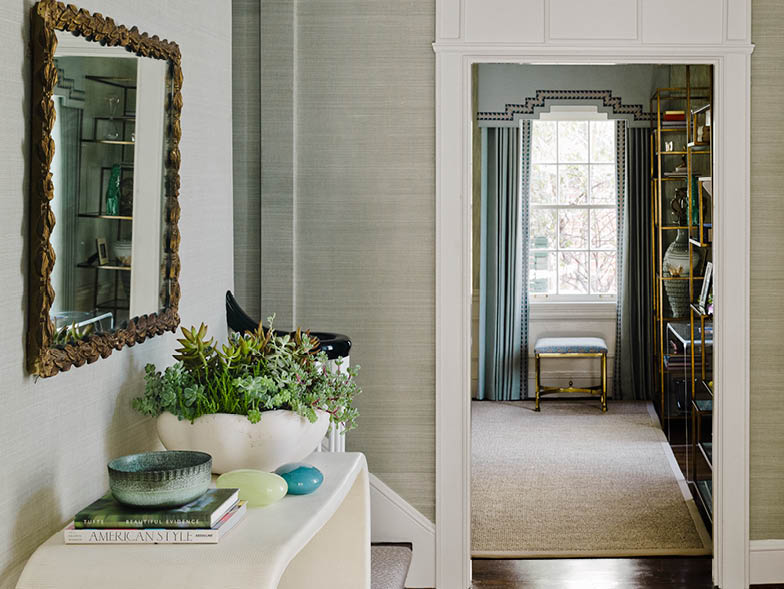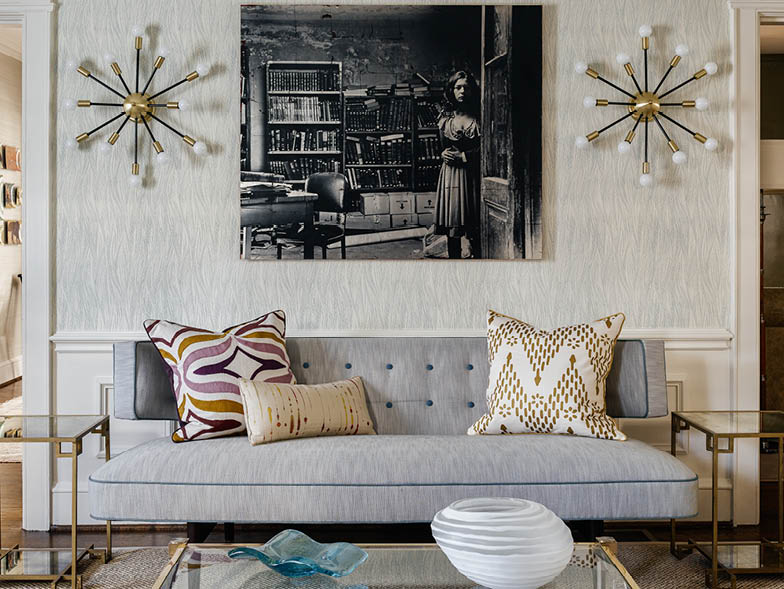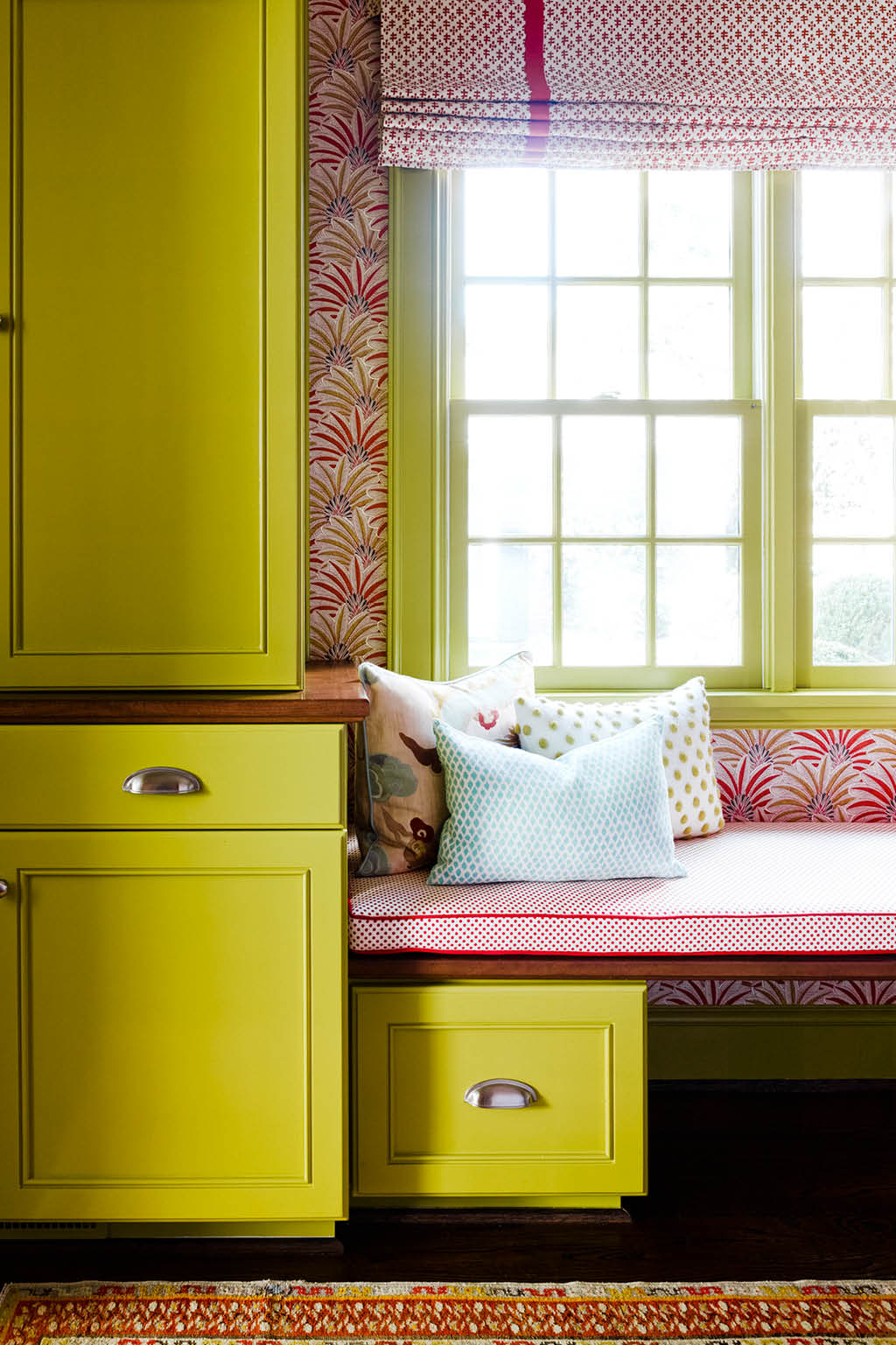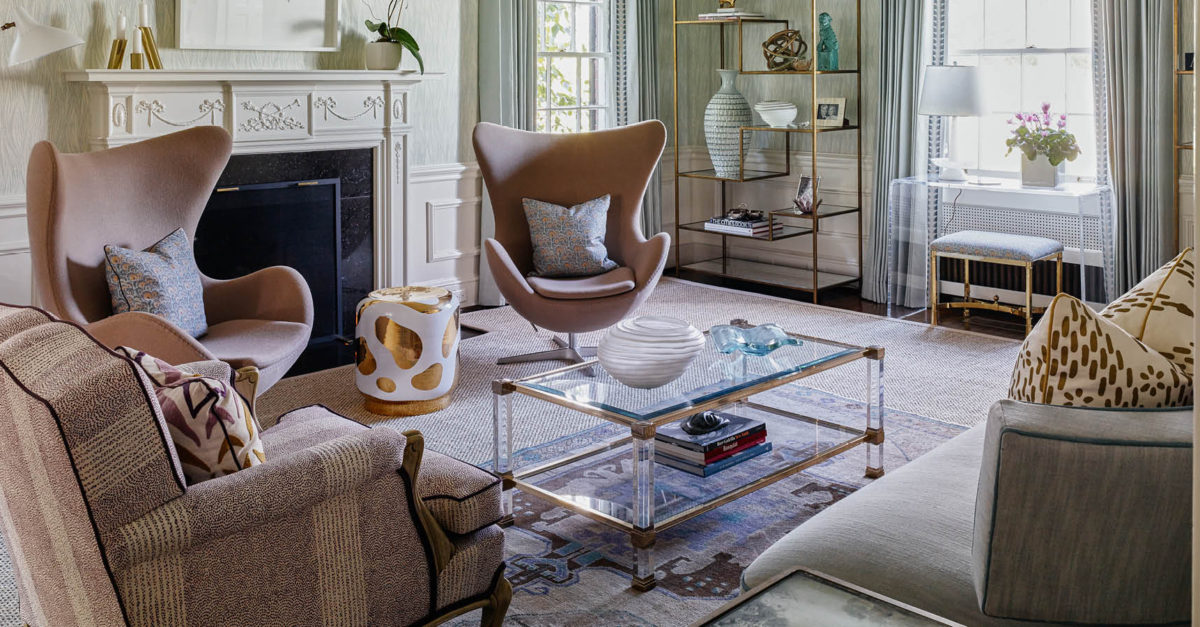Charlotte Composition
With a North Carolina upbringing and an interior designer mother, Charlotte Lucas got an early start on the world of design. After working in Washington, DC, she returned to her roots and opened her own firm, which is known for using bold colors and vintage pieces. She discusses how she deftly combined modern and traditional, and northern and southern touches in a recent home project for a transplanted New York couple.
How did your family influence your love of design? Do you recall any stories or experiences from your youth that were precursors of your future as an interior designer?
My mother is an interior designer, so my childhood was filled with trips to flea markets, antique stores, and furniture and fabric showrooms. We are both do-it- yourselfers, and I have fond memories of the two of us rag-rolling my bedroom in the early ’90s. Both of my sisters are designers as well, so it may be safe to say it’s genetic at this point!
You studied design at the University of Georgia and worked in Washington, DC, but then you returned to work in North Carolina and opened your own design firm there in 2012.What led you back home?
Family brought me back to my North Carolina roots. My husband is also from Charlotte, and we both decided to move back here in 2007. Charlotte is a booming city with so much opportunity, and it’s far different from when we grew up here.
What did you learn from the Charlotte-area designers with whom you worked?
I learned a lot about running a business: sacrifice, reward, dedication, time management, organization, discipline, and delegation. I’ve always worked at boutique firms, where everyone wears many hats, so you must have a humble attitude and a good work ethic!
Which other designers have influenced you or inspired you?
Designers from the past inspire me. It’s nice to look back on a design from seventy years ago and see something relevant and inspirational for a project today. I love vintage furniture from the ’50s and ’60s, and I admire the designs of Tommi Parzinger, Edward Wormley, William Haines, Billy Baldwin, and Dorothy Draper, to name a few.

What are the biggest advantages and disadvantages of running your own design firm versus working for somebody else?
When you work for yourself, the sky is the limit! With that comes tremendous risk (and stress), but with great risk there is also great reward. At the end of the day, you are the only one to blame if something isn’t right.
How would you describe your style?
I make a concerted effort to let the project and the client dictate the overall aesthetic. A house should feel like it belongs to that family, and I am hired to curate the design accordingly. I love furniture with a story—whether we know the story or not. I mix lots of colors, patterns, and materials in my projects. I also sometimes joke that I was born in the wrong decade because so much of my inspiration comes from the 1950s and 1960s. I do a lot of treasure hunting for vintage furniture and use those finds in my projects. Sometimes a house calls for clean lines, and, at other times, things need to be a little fussier.
Since you work primarily in the Southeast, how do traditional southern-style architecture styles in the homes you design influence your projects and design decisions, if at all?
The South is rich in tradition, but we are modernizing the way we live here and what that means. It’s important to keep memories and heirlooms alive in a southern house, whether it’s your grandmother’s china, an old chest, or antique linens. However, houses have evolved, and we don’t necessarily lean toward the formal spaces and furniture that were typical of our great-grandparents’ era.
Southern architecture plays a big role in design as well. I’ve worked on beautiful pre-Civil War houses in Charleston, South Carolina, that are protected by historical preservation and conservation boards to keep these historic buildings alive and well. There is so much character in these old houses. When working on a project like that, I always try to complement the history of the house with the furnishings in an updated and modernized way without disconnecting it from its roots.
How important is spacing to you? What steps do you take to ensure that a room’s spacing and flow are good?
Space planning and scale are critical. I always present a hand-drawn, scaled floor plan to the client so he or she can understand the spacing and layout of a room. I also provide a hand-drawn full-room rendering, which provides a clear visual of the space and makes it easy for the client and me to make adjustments before anything is ever ordered.

One word: color. What does it mean to you as a designer?
I firmly believe that the use of bold and bright colors can help keep a room or a house fresh and exciting over the years. Color evokes emotion, and I think it’s important to be excited when you walk through your house. It’s a challenge for me to design a neutral room!
Are there any colors, patterns, or textures you would never use?
I’m not sure I’ve ever met a color, pattern, or texture I didn’t like. Almost every one has a place if used in the right way for the right project. I love finding opportunities to use less common or out-of-style elements to force myself to think outside the box.
What are some key questions you ask a client to get a sense of design direction?
I have three: How does your family use your house? What are the important pieces you want to keep? And are there any colors or designs you dislike?
You seem to have fun with design (and fashion, for that matter), and you seem to genuinely enjoy what you’re doing. What makes the job fun? How does that reflect in your work?
I wouldn’t do what I do unless I loved it. It is truly a passion, and I am so fortunate to be able to get up every morning and go do something I love. There are tough days, for sure, but the reward of a finished house and a happy client outweighs any tough days. I’m a living embodiment of what following your passions can do for your life and your career. I think it’s important to remember that we are designing, not saving lives, so we should have fun while we work!
Where is this featured project located? Who were the clients, and what were their goals for the project?
This house is in Charlotte. It was built in 1930 and is in one of the oldest and most traditional neighborhoods in Charlotte. He is from the United Kingdom, and she is from New York. We started the project with a blank slate except for a pair of Egg Chairs from their New York City apartment. This living room is a wonderful mix of traditional and modern styles. Explain what details you added to make this combination work so well: The living room is a blend of modernized, traditional Charlotte with a dash of their New York City roots. We kept the original elements of the room, like the fireplace and the chair rail molding, and blended in their Egg Chairs to help modernize the space and make the room feel a little less formal.
Some areas are mostly neutral with pops of color (like the entry), while other areas feature primarily bold colors. What dictated which would prevail in each area?
The entry is a little more subdued and sophisticated, but as you walk through the house to the more casual areas, it gets more fun and whimsical. You don’t want to give away all the excitement as soon as you walk in!
The study is bursting with color. What inspired you to go with green as the primary color for this particular area?
We were set on painting the study a rich color, and blue seemed to be the obvious choice; however, we put some samples on the wall and weren’t impressed. The colors were fine, but it wasn’t exciting. So we went back to the paint deck and came up with the green—it felt different from the blue and looked great with the furniture they already had, so we just went with it. I’d like to say it was more thought through, but it was really just trial and error until we found what was right.

What inspired the summery color combination in the reading nook?
It is such a tiny space and a big kid zone, so the clients were up for something fun. We selected the wallpaper first and shortly thereafter decided to go big with the yellow paint. It’s a happy spot with lots of natural light from the window. I must add that it takes very trusting clients to paint a room bright mustard yellow!
The kitchen lets in a lot of natural light. How did that factor into your design decisions?
It gets wonderful afternoon light, and since there is a lot of fun color around the house, we wanted this kitchen to feel a little more crisp and clean. It is usually busy with kids, and the kitchen table is always a gathering place for an arts and crafts activity, so taking that into consideration, it felt right to keep most of the kitchen white and serene.
What was your inspiration for the lighting above the island?
The poppy red lanterns are a fun addition that play off the reds in the banquette and reading nook. I didn’t want the light fixtures to get washed out in the room, so the poppy red provides a grounding center point for the space.
The island color also stands out. What made you decide it was perfect for this space?
The island color was meant to ground the space (with the assistance of the poppy lanterns). In an all-white kitchen, I wanted to have a substantial color in the center of the room. Since the banquette has fun colors, too, these play off each other.
This banquette is very comfortable and welcoming. What did you add to this space to enhance it?
We made a new cushion from a sturdy vinyl fabric that could stand up to the day-to-day spills and arts and crafts projects. I wanted it to be comfortable without the upholstered back, so we added lots of throw pillows. Explain what the juxtaposition of wood and white brings to the banquette: Mixing materials always creates a more layered look. I loved mixing the soft fabrics of the banquette with the walnut from the table and the cane in the chairs.
If you weren’t an interior designer, what would be your career choice?
A horticulturist. I have recently discovered a love for gardening since my husband and I bought our new house several years ago. I am far from having a green thumb, but I’ve loved learning about our yard and the changes each season brings. I have a small herb-and- vegetable garden that my daughter and I started. It has become a family affair, and the kids love helping me pick the veggies. I’ve also learned that they are far more likely to eat veggies they grew and picked than something we bought at the store.
From a personal perspective, what would be the most exciting item you could find at a flea market or an antique store?
I love finding vintage linens that are monogrammed with a letter of someone in our family or old silver with an “L” monogram. I also love finding great vintage fabrics or trims at flea markets.
What do you enjoy doing in your spare time?
What spare time? [laughs] Any spare time I have outside of work is spent with my kids, Liles and Townes. We love going up to the North Carolina mountains on the weekends. It’s one of the few places I am able to truly disconnect from the hustle of everyday life.
If you could describe how you feel about your life overall, at this moment in time, in just one word, what would it be?
Fulfilled. My life is crazy with two kids and a full-time job, but I feel so fortunate that I’m able to get so much joy and fulfillment amid the chaos.
For more info, visit charlottelucasdesign.com






















